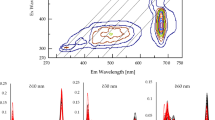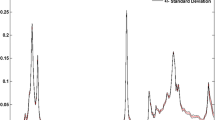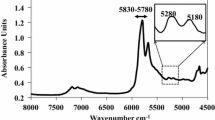Abstract
Fluorescence spectrometry, combined with principle component analysis, partial least-squares regression (PLSR) and artificial neural network (ANN), was applied for the analysis of Maltese extra virgin olive oil (EVOO) adulterated by blending with vegetable oil (corn oil, soybean oil, linseed oil, or sunflower oil). The novel results showed that adjusted PLSR models based on synchronised spectra for detecting the % amount of EVOO in vegetable oil blends had a lower root mean square error (0.02–6.27%) and higher R2 (0.983–1.000) value than those observed when using PLSR on the whole spectrum. This study also highlights the use of ANN as an alternative chemometric tool for the detection of olive oil adulteration. The performance of the model generated by the ANN is highly dependent both on the type of data input and the mode of cross validation; for spectral data which had a variable importance plot value > 0.8 the excluded row cross validation was more appropriate while for complete spectral analysis k-fold or CV-10 was more appropriate.



Similar content being viewed by others
References
Aguado D, Montoya T, Borras L, Seco A, Ferrer J (2008) Using SOM and PCA for analysing and interpreting data from a P-removal SBR. Eng Appl Artif Intell 21:919–930
Baccouri O, Guerfel M, Baccouri B, Cerretani L, Bendini A, Lercker G, Zarrouk M, Miled DDB (2008) Chemical composition and oxidative stability of Tunisian monovarietal virgin olive oils with regard to fruit ripening. Food Chem 109(4):743–754
Bosque-Sendra JM, Cuadros-Rodríguez L, Ruiz-Samblás C, De La Mata AP (2012) Combining chromatography and chemometrics for the characterization and authentication of fats and oils from triacylglycerol compositional data: a review. Anal Chim Acta 724:1–11
Calvano CD, De Ceglie C, D’Accolti L, Zambonin CG (2012) MALDI-TOF mass spectrometry detection of extra-virgin olive oil adulteration with hazelnut oil by analysis of phospholipids using an ionic liquid as matrix and extraction solvent. Food Chem 134(2):1192–1198
Dong W, Zhang Y, Zhang B, Wang X (2012) Quantitative analysis of adulteration of extra virgin olive oil using Raman spectroscopy improved by Bayesian framework least squares support vector machines. Anal Methods 4:2772–2777
EEC (2013) Commission Implementing Regulation (EU) No 1348/2013 amending Regulation (EEC) No 2568/91 on the characteristics of olive oil and olive-residue oil and on the relevant methods of analysis
Eriksson L, Kettaneh-Wold N, Trygg J, Wilkstrom C, Wold S (2006) Multi- and megavariate data analysis, basic principles and application, 2nd edn. Umetrics AB, Umea, Sweden
Fragaki G, Spyros A, Siragakis G, Salivaras E, Dais P (2005) Detection of extra virgin olive oil adulteration with lampante olive oil and refined olive oil using nuclear magnetic resonance spectroscopy and multivariate statistical analysis. J Agric Food Chem 53(8):2810–2816
Giungato P, Aveni M, Rana R, Notarnicola L (2004) Modifications induced by extra virgin olive oil frying processes. Ind Aliment 43:369–375
Gliszczyńska-Świgło A, Sikorska E, Khmelinskii I, Sikorski M (2007) Tocopherol content in edible plant oils. Pol J Food Nutr Sci 57(4):157–161
Guimet F, Ferré J, Boqué R (2005) Rapid detection of olive pomace oil adulteration in extra virgin olive oils from the protected denomination of origin Siurana using excitation–emission fluorescence spectroscopy and three-way methods for analysis. Anal Chim Acta 544:143–152
Herchi W, Arráez-Román D, Boukhchina S, Kalle H, Segura-Carretero A, Fernández-Gutierrez A (2012) A review of the methods used in the determination of flaxseed components. Afr J Biotechnol 11(4):724–731
Jiang L, Zheng H, Lu H (2013) Application of UV spectrometry and chemometric models for detecting olive oil-vegetable oil blends adulteration. J Food Sci Technol 52:479–485
Kamal-Eldin A, Andersson R (1997) Multivariate study of the correlation between tocopherol content and fatty acid composition in vegetable oils. J Am Oil Chem Soc 74:375–380
Kyriakidis NB, Skarkalis P (2000) Fluorescence spectra measurement of olive oil and other vegetable oils. J Am Oil Chem Soc 83:1435–1439
Maggio RM, Kaufman TS, Carlo MD, Cerretani L, Bendini A, Cichelli A, Compagnone D (2009) Monitoring of fatty acid composition in virgin olive oil by Fourier transformed infra-red spectroscopy coupled with partial least square. Food Chem 114:1549–1554
Maggio RM, Cerretani L, Chiavaro E, Kaufman TS, Bendini A (2010) A novel chemometric strategy for the estimation of extra virgin olive oil adulteration with edible oils. Food Control 21(6):890–895
Matthäus B, Özcan MM (2011) Determination of fatty acid, tocopherol, sterol contents and 1,2- and 1,3-diacylglycerols in four different virgin olive oil. J Food Process Technol 2:117
Mignani AG, Ciaccheri L, Ottevaere H, Thienpont H, Conte L, Marega M (2011) Visible and near-infrared absorption spectroscopy by an integrating sphere and optical fibers for quantifying and discriminating the adulteration of extra virgin olive oil from Tuscany. Anal Bioanal Chem 399(3):1315–1324
Papadopoulos K, Triantis T, Tzikis CH, Nikokavoura A, Dimotikali D (2002) Investigations of extra virgin olive oils with seed oils using weak chemiluminescence. Anal Chim Acta 464(1):135–140
Pasqualone A, Montemurro C, di Rienzo V, Summo C, Paradiso VM, Caponio F (2016) Evolution and perspectives of cultivar identification and traceability from tree to oil and table olives by means of DNA markers. J Sci Food Agric 96(11):3642–3657
Poulli KI, Mousdis GA, Georgiou CA (2006) Synchronous fluorescence spectroscopy for quantitative determination of virgin olive oil adulteration with sunflower oil. Anal Bioanal Chem 386(5):1571–1575
Poulli KI, Mousdis GA, Georgiou CA (2007) Rapid synchronous fluorescence method for virgin olive oil adulteration assessment. Food Chem 105:369–375
Rahmani M, Saari-Csallany A (1998) Role of minor constituents in the photoxidation of virgin olive oil. J Am Oil Chem Soc 75:837–843
Souci SW, Fahman W, Kraut H (1994) Food composition and nutrition tables, 5th edn. CRC Press, Florida, United States
Sikorska E, Romaniuk A, Khmelinskii IV, Herance R, Bourdelande JL, Sikorski M, Koziol J (2004) Characterization of edible oils using total luminescence spectroscopy. J Fluoresc 14:25–35
Sikorska E, Khmelinskii I, Sikorski M (2012) Analysis of olive oils by fluorescence spectroscopy: Methods and applications. In: Dimitrios Boskou (ed) Agricultural and Biological Sciences – Olive Oil – Constituents, Quality, Health Properties and Bioconversions. AOCS Press, Urbana, Illinois, United States, pp 63–88
Solari ME, Vernet JL (1992) Late glacial and Holocene vegetation of the Corbières based on charcoal analysis at the Cova de L’Espérit (Salses, Pyrénées Orientales, France). Rev Palaeobot Palynol 71:111–120
Terral JF, Arnold-Simard G (1996) Beginnings of olive cultivation in eastern Spain in relation to Holocene bioclimatic changes. Quat Sci Rev 46:176–185
Zandomeneghi M (2006) Fluorescence spectroscopy excitation-emission methods combined with three-way analysis as a complementary technique for the characterization of olive oil. J Agric Food Chem 54(14):5214–5215
Zheng H, Lu HF (2011) Use of kinetic, Weibull and PLSR models to predict the retention of ascorbic acid, total phenols and antioxidant activity during storage of pasteurized pineapple juice. LWT Food Sci Technol 44:1273–1281
Acknowledgements
The research carried out was funded by the Malta Government Scholarships Post-Graduate Scheme for 2014 (MGSS-PG 2014).
Author information
Authors and Affiliations
Corresponding author
Rights and permissions
About this article
Cite this article
Lia, F., Morote Castellano, A., Zammit-Mangion, M. et al. Application of fluorescence spectroscopy and chemometric models for the detection of vegetable oil adulterants in Maltese virgin olive oils. J Food Sci Technol 55, 2143–2151 (2018). https://doi.org/10.1007/s13197-018-3131-0
Revised:
Accepted:
Published:
Issue Date:
DOI: https://doi.org/10.1007/s13197-018-3131-0




